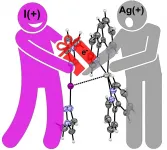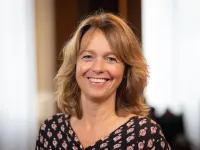(Press-News.org) If you're poor and terminally ill in southern Mexico, there's far less chance you'll get the painkillers you need for palliative care than your cousins in more prosperous regions, particularly those pharmacy-rich areas along Mexico-U.S. border, say UCLA researchers and colleagues who studied opioid dispensing levels across the country.
What's more, the researchers' paper in the journal The Lancet Public Health suggests it's likely that some of the opioids intended for Mexican citizens are ending up in American pockets.
Despite a Mexican government initiative launched in 2015 to improve access to prescription opioids among palliative care patients, the country has seen only a marginal increase in dispensing levels, and inequities in dispensing have left many of the nation's poorest residents without comfort in their final days, said lead author Dr. David Goodman-Meza, an assistant professor of medicine in the infectious diseases division at the David Geffen School of Medicine at UCLA.
"People in the poorest areas of Mexico are dying in pain," Goodman-Meza said. "A lot of work needs to be done to increase access to opioids for those who have a medical need for them in Mexico."
The researchers analyzed data on prescription drug dispensing from August 2015 to October 2019 for all 32 Mexican states and six large metropolitan areas. They compared opioid prescribing levels against the expected need for the drugs based on the burden of disease in each state.
While they found that opioid dispensing had increased overall by an average of 13% per quarter over that period, they also discovered that dispensing levels were nearly 10 times higher in states whose populations had the highest socioeconomic status than in those with the lowest. In addition, higher socioeconomic status was also associated with increased opioid dispensing within individual neighborhoods in the six metropolitan areas.
The states with the highest opioid prescribing rates were Baja California (234.5 prescriptions per 10,000 residents), Mexico City (65.8 per 10,000), Nuevo Leon (58.7 per 10,000), Sonora (56.5 per 10,000) and Jalisco (51.9 per 10,000). Those with the lowest rates were Tlaxacala (0 per 10,000), Guerrero (0.6 per 10,000), Durango (2.7 per 10,000), Mexico state (4.3 per 10,000), and Tabasco (4.4 per 10,000).
Baja California, Nuevo Leon and Sonora all border the U.S., while Mexico City is its own state and sits between Mexico state and Tlaxacala in central Mexico.
Fentanyl was the most frequently dispensed of the medications, at 35.7% of the total, followed by methadone (26.5%), morphine (23.8%), tapentadol (7.3%), oxycodone (6.9%) and hydromorphone (0.2%).
The researchers note that large referral hospitals, where advanced-stage diseases are treated, tend to be concentrated in Mexico's larger, more prosperous cities and states. In addition, the high cost of the medications may put them out of reach for poorer populations, disincentivizing pharmacies in poorer areas from carrying them.
The researchers also say that many pharmacies' close proximity to entry ports along the northern border may make it easier for people in the U.S. to cross over and obtain these drugs, putting a strain on U.S. efforts to curb its opioid epidemic. Though the researchers did not focus on this and do not have cross-border purchase data, they note in the paper that these potential pathways into the U.S. bear monitoring.
"As the U.S. has tried to curb the epidemic related to prescription opioids by instituting structural mechanisms such as closing 'pill mills' and instituting prescription drug monitoring programs, individuals may be getting around them by going to Mexico to get opioids," Goodman-Meza said. "Continued surveillance at border crossings is necessary to avoid unmonitored entry of opioids into the U.S."
The study findings are limited by several other factors, among them a lack of patient- or provider-level data, the fact that the researchers did not analyze differences between the many medical systems providing care and the possibility that some institutions did not submit data to the Mexican government.
INFORMATION:
The National Institutes of Health funded this study.
Additional study authors are Joseph Friedman, Mariah Kalmin, Emmanuel Aguilar-Posada, Marissa Seamans, Michael Shin and Steve Shoptaw, all of UCLA; Steffanie Strathdee of UC San Diego; Clara Fleiz of Mexico's Instituto Nacional de Psiquiatría Ramón de la Fuente Muñiz; and Jaime Arredondo-Sanchez and Sara Velazquez-Moreno of Mexico's Centro de Investigación y Docencia Económicas.
A novel computer algorithm, or set of rules, that accurately predicts the orbits of planets in the solar system could be adapted to better predict and control the behavior of the plasma that fuels fusion facilities designed to harvest on Earth the fusion energy that powers the sun and stars.
The algorithm, devised by a scientist at the U.S. Department of Energy's (DOE) Princeton Plasma Physics Laboratory (PPPL), applies machine learning, the form of artificial intelligence (AI) that learns from experience, to develop the predictions. "Usually in physics, you make observations, create a theory based on those observations, and then use that theory to predict new observations," said PPPL physicist Hong Qin, author of a paper detailing ...
Monash University researchers have uncovered the barrier to β-cell (beta cell) regeneration that could pave the way for improved treatments for diabetes and diseases that involve organ and tissue damage.
The human body doesn't repair itself very well, with our liver the only organ that can regenerate efficiently. We have limited capacity to regenerate new cells or tissue after birth as the genes involved in development are switched off.
This process happens through DNA methylation, a biological process where chemicals (methyl groups) are written on DNA and modify the way the gene functions. ...
A team of researchers at Lawrence Berkeley National Laboratory (Berkeley Lab) used a quantum computer to successfully simulate an aspect of particle collisions that is typically neglected in high-energy physics experiments, such as those that occur at CERN's Large Hadron Collider.
The quantum algorithm they developed accounts for the complexity of parton showers, which are complicated bursts of particles produced in the collisions that involve particle production and decay processes.
Classical algorithms typically used to model parton showers, such ...
An international research team led by Professor Kari Rissanen of the University of Jyvaskyla (Finland) and Professor Antonio Frontera of the University of Balearic Islands (Spain) has demonstrated that positively charged iodine (termed iodonium) is able to favorably interact with a silver cation (Ag+), overcoming the strong electrostatic repulsion. The research was published online in Chem -journal 8th of February 2021.
It is well known and intuitive that iodide (I-) has a strong affinity for Ag+. For instance, AgI is one of the most insoluble inorganic salts ...
When we listen to speech sounds, the information that enters our left and right ear is not exactly the same. This may be because acoustic information reaches one ear before the other, or because the sound is perceived as louder by one of the ears. Information about speech sounds also reaches different parts of our brain, and the two hemispheres are specialised in processing different types of acoustic information. But how does the brain integrate auditory information from different areas?
To investigate this question, lead researcher Basil Preisig from the University of Zurich collaborated with an international team of scientists. In an earlier study, the team discovered that the brain integrates information about speech sounds by 'balancing' the rhythm of gamma waves across ...
Most countries introduced school closures during the spring of 2020 despite substantial uncertainty regarding the effectiveness in containing SARS-CoV-2. In Sweden, upper-secondary schools moved online while lower-secondary schools remained open. A comparison of parents with children in the final year of lower-secondary and first year of upper-secondary school shows that keeping the former open had limited consequences for the overall transmission of the virus. However, the infection rate doubled among lower-secondary teachers relative to upper-secondary ones. The infection rate among partners of lower-secondary teacher was 30 percent higher than among their upper-secondary counterparts.
On March 18, 2020, Swedish ...
T lymphocytes, or T cells, are an important component of our immune system. They can recognize foreign proteins, so-called antigens, as peptide fragments - for instance, those derived from viruses or cancer cells. In principle, they could, but usually do not, attack our own ('self') proteins. "That is why it is important for the organism to tightly control the activities of T cells," says Dr. Reinhard Obst, head of a research group at the Institute for Immunology at LMU's Biomedical Center that studies the activation of T cells. The project contributed to the Collaborative Research Center 1054 that explores the plasticity of cell fate decisions in the immune system.
When ...
Scientists use many different tests to investigate what happens in the brain in people experiencing stress. It is unclear to what extent the various methods with which subjects are placed under stress are comparable to each other. In a meta-analysis, a biopsychology team from Ruhr-Universität Bochum compared 31 previous studies that had investigated stress using functional magnetic resonance imaging (fMRI). The team worked out which regions of the brain are activated as standard during stress and which stress tests trigger similar activation patterns. They describe the results in the journal Neuroscience and Biobehavioral Reviews, published online on 5 February 2021.
To conduct the work, ...
The move from the ancient system of £sd coinage to 100p to £1 was controversial, considered by some to be a sign of the UK's receding importance on the world stage and even as the beginning of the tumultuous relationship with Europe that ultimately led to Brexit.
But as a result of extensive analysis of a quiet backwater of recent history, Andy argues that the move towards decimalisation had little to do with Europe and in fact was a traditional British compromise.
"It was an event that I remember from my youth, but I found that ...
Biomarkers play a central role in the diagnosis of disease and assessment of its course. Among the markers now in use are genes, proteins, hormones, lipids and other classes of molecules. Biomarkers can be found in the blood, in cerebrospinal fluid, urine and various types of tissues, but most of them have one thing in common: They occur in extremely low concentrations, and are therefore technically challenging to detect and quantify.
Many detection procedures use molecular probes, such as antibodies or short nucleic-acid sequences, which are designed to bind to specific biomarkers. When a probe recognizes and binds to its target, chemical or physical reactions give rise to fluorescence signals. Such methods work well, provided they are sensitive enough to recognize ...






